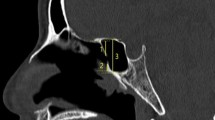Abstract
Purpose
The aim of the study is to investigate the relation between paranasal sinus volumes and headache in patients with no other rhinologic causes.
Methods
Two hundred patients with chronic headache and 99 subjects with no headache or facial pain history in the last 6 months were included in the study. Paranasal computed tomography (CT) scans of both patient and control groups were evaluated. Sixty one patients were excluded from the study due to possible rhinogenic headache CT findings such as secretions and contact points. Sinus volume index (SVI) formula created by Barghouth et al. in 2002 was used to calculate paranasal sinus volumes: SVI = ½. A × B × C. Mann–Whitney U test was used to compare an independent continuous variable and a continuous variable with non-normal distribution.
Results
In the patient group, the total sinus, frontal sinus, and maxillary sinus volumes were found to be significantly lower than those of the control group (p < 0.001). Although the total sphenoid sinus volume was found to be lower in the patient group, there was no significant difference between the two groups (p = 0.013).
Conclusion
Although rhinogenic findings are often related to secondary headache, the relation between paranasal sinus volume and headache is scarcely investigated in the literature. Our study showed that paranasal sinus volumes might have a role in secondary headaches. Furthermore, in contrast to the literature, our study showed a significant relation between headache and smaller paranasal sinus volumes.


Similar content being viewed by others
References
Lucado J, Paez K, Elixhauser A (2006) Headaches in U.S. Hospitals and Emergency Departments, 2008: Statistical Brief #111. Healthcare Cost and Utilization Project (HCUP) Statistical Briefs. Rockville (MD)
Levin M (2015) Approach to the workup and management of headache in the emergency department and inpatient settings. Semin Neurol 35(6):667–674
Olesen J, Steiner T (2004) The international classification of headache disorders, 2nd edn (ICDH-II). BMJ Publishing Group Ltd, London
Roozbahany NA, Nasri S (2013) Nasal and paranasal sinus anatomical variations in patients with rhinogenic contact point headache. Auris Nasus Larynx 40(2):177–183
Bieger-Farhan AK, Nichani J, Willatt DJ (2004) Nasal septal mucosal contact points: associated symptoms and sinus CT scan scoring. Clin Otolaryngol Allied Sci 29:165–168
Abu-Bakra M, Jones NS (2001) Does stimulation of the nasal mucosa cause referred pain to the face? Clin Otolaryngol Allied Sci 26:430–432
Urken ML, Som PM, Edelstein D, Lawson W, Weber AL, Biller HF (1987) Abnormally large frontal sinus. II. Nomenclature, pathology, and symptoms. Laryngoscope 97:606–611
Herzallah IR, Hamed MA, Salem SM, Suurna MV (2015) Mucosal contact points and paranasal sinus pneumatization: does radiology predict headache causality? Laryngoscope 125(9):2021–2026
Barghouth G, Prior JO, Lepori D, Duvoisin B, Schnyder P, Gudinchet F (2002) Paranasal sinuses in children: size evaluation of maxillary, sphenoid, and frontal sinuses by magnetic resonance imaging and proposal of volume index percentile curves. Eur Radiol 12:1451–1458
Cady RK, Dodick DW, Levine HL, Schreiber CP, Eross EJ, Setzen M et al (2005) Sinus headache: a neurology, otolaryngology, allergy, andprimary care consensus on diagnosis and treatment. Mayo Clin Proc 80(7):908–916
Patel ZM, Kennedy DW, Setzen M, Poetker DM, DelGaudio JM (2013) “Sinus headache”: rhinogenic headache or migraine? An evidence-based guide to diagnosis and treatment. Int Forum Allergy Rhinol 3:221–230
Lipton RB, Diamond S, Reed M, Diamond ML, Stewart WF (2001) Migraine diagnosis and treatment: results from the American Migraine Study II. Headache 41:638–645
Kousoulis P, Hajiioannou J, Florou V, Kretzas D, Korres GJ (2013) Excessive paranasal sinuses and mastoid aeration as a possible cause of chronic headache. Case Rep Otolaryngol. https://doi.org/10.1155/2013/836064
Caylakli F, Cagici AC, Yilmazer C, Ozer F, Ozluoglu LJANL (2006) Hyperaeration of the frontal sinus. Auris Nasus Larynx 33:471–473
Cady RK, Schreiber CP (2009) Sinus problems as a cause of headache refractoriness and migraine chronification. Curr Pain Headache Rep 13:319–325
Ferrero V, Allais G, Rolando S, Pozzo T, Allais R, Benedetto CJ (2014) Endonasal mucosal contact points in chronic migraine. Neurol Sci 35:83–87
Bašić N, Bašić V, Jukić T, Bašić M, Jelić M, Hat J (1999) Computed tomographic imaging to determine the frequency of anatomical variations in pneumatization of the ethmoid bone. Eur Arch Otorhinolaryngol 256:69–71
Funding
There is no financial supporter for this study.
Author information
Authors and Affiliations
Corresponding author
Ethics declarations
Conflict of interest
There is no conflict of interest among the authors.
Additional information
Publisher's Note
Springer Nature remains neutral with regard to jurisdictional claims in published maps and institutional affiliations.
Rights and permissions
About this article
Cite this article
Aydemir, L., Doruk, C., Çaytemel, B. et al. Paranasal sinus volumes and headache: is there a relation?. Eur Arch Otorhinolaryngol 276, 2267–2271 (2019). https://doi.org/10.1007/s00405-019-05461-1
Received:
Accepted:
Published:
Issue Date:
DOI: https://doi.org/10.1007/s00405-019-05461-1




